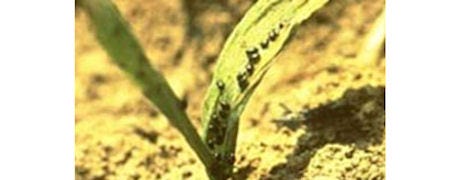March 23, 2014

Corn flea beetle, which targets corn through the spread of the bacterium that causes Stewart's bacterial wilt and leaf blight in both field and sweet corn, likely won't be seen throughout much of the state this year, says Ron Hammond, an Ohio State University Extension entomologist.
Adult beetles that overwinter become active in the spring when the soil temperature reaches 65 degrees, and are most active on sunny, warm, windless days. Higher populations of the flea beetle survive during milder winters than during cold winters.

Cold Weather Blasts Flea Beetles
Using a "flea beetle index" that calculates the average sum temperature of December, January and February to predict the likelihood of the disease threat, OSU Extension researchers have found that all areas of the state have indexes of less than 90, suggesting that the risk is negligible for the pest and disease this year, Hammond said.
"Flea beetle is one of the few insects that is predictable on whether or not the region experiences a cold winter," he says. "This is one example of how a harsh winter with extreme cold temperatures can have a positive impact.
"However, growers should still scout for flea beetles, especially if they have planted a hybrid that is susceptible to Stewart's disease."
But most field corn typically planted now, especially all transgenic hybrids, already come with an insecticide seed treatment applied, Hammond says.
"So it is mostly non-transgenic corn that might need to be considered and watched more closely," he says.
Also, most field corn hybrids are more resistant to wilt than sweet corn, with dent corn hybrids varying greatly in their resistance to the leaf blight stage phase of the disease, Hammond said. He noted that sweet corn varieties are often susceptible to wilt in the first leaf stage.
"A few are resistant by the second leaf stage and many are resistant in the third and fourth leaf stage," he says. "Consult your seed supplier for information on resistant varieties and hybrids."
You May Also Like




